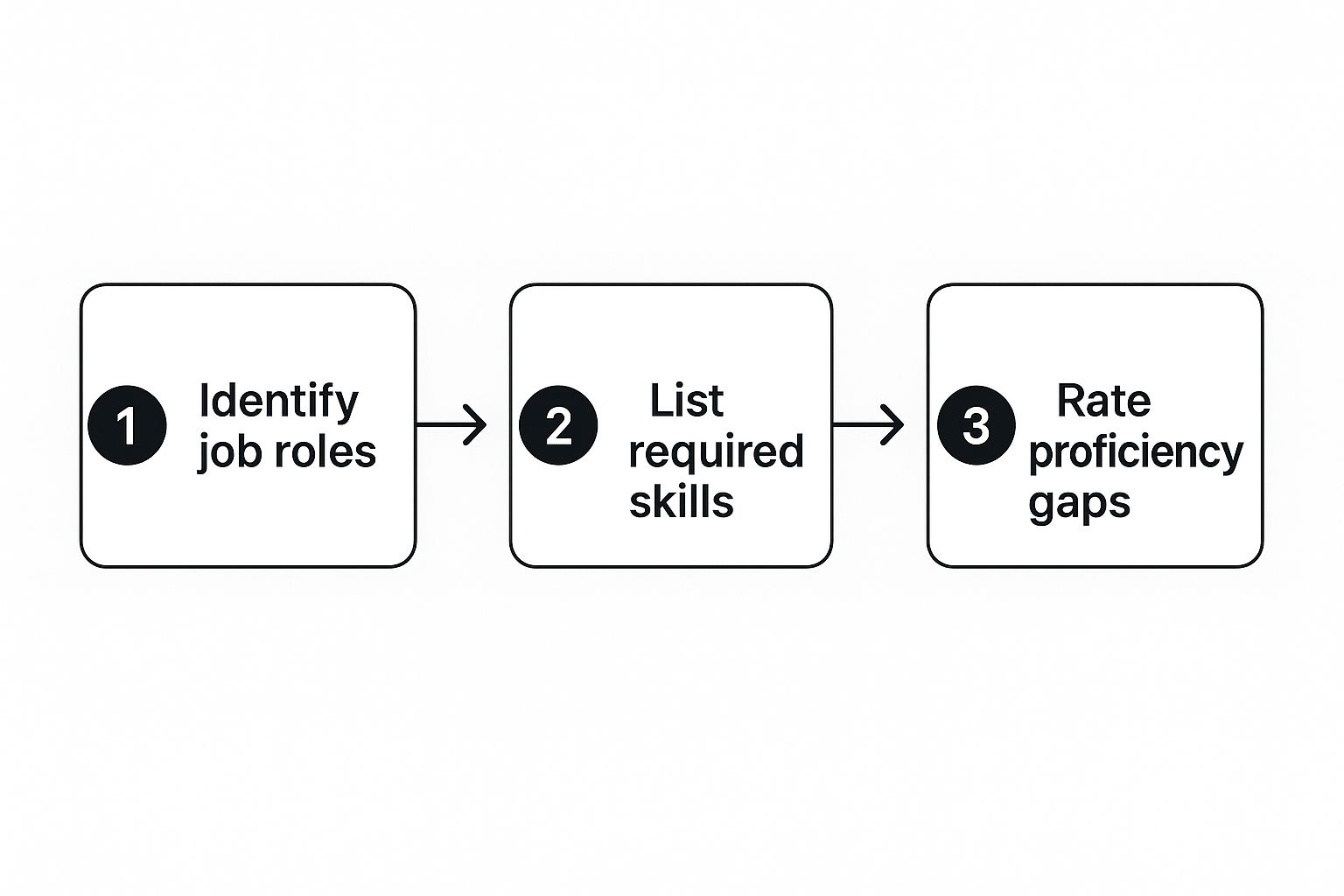Your Skills Gap Analysis Template for Future Success
- Ron Smith

- Sep 2
- 10 min read
A skills gap analysis template isn't just another HR form. It's a strategic tool that helps you map out the skills your team actually has against the skills you need to hit your future goals. It takes a messy, complex workforce problem and turns it into a clear, actionable plan for navigating emerging trends in workforce management, technology, and contingent labor.
Why a Skills Gap Analysis Is No longer Optional

Let’s be honest—the skills that got us here won't get us there. The things that made a business successful just a few years ago are quickly becoming table stakes, or worse, obsolete.
That's why a skills gap analysis has gone from a "nice-to-have" HR exercise to a core survival strategy. It's driven by two massive forces you can't ignore: relentless advancements in technology like AI and a complete shift in how we build our teams.
The World Is Changing Faster Than Your Job Descriptions
Today's work environment is in a constant state of flux. New technology, especially AI and automation, is rewiring job roles at a dizzying pace. This isn't some far-off prediction; it's happening right now, impacting your team's daily output and your company's bottom line.
Think about this: by 2025, it's predicted that automation and AI will disrupt about 44% of essential worker skills. That’s a massive challenge staring us in the face, creating an urgent need to get people trained on what's next.
It's no wonder a staggering 87% of executives see major skills gaps coming down the pipeline. They know they need to get a handle on this before it stalls their growth. For a deeper dive into these trends, sethmattison.com offers some great insights on future-proofing your workforce.
Your Workforce Isn't What It Used To Be
It's not just about technology. The very makeup of our teams is different. The gig economy, freelance specialists, and a global talent pool are no longer niche concepts—they're central to modern workforce management.
More and more, companies are turning to contingent labor and a new kind of staff augmentation to find highly specialized skills without the long-term overhead. This new reality makes a skills gap analysis absolutely essential. Here's why:
It aligns people with strategy. You can finally connect your talent plan directly to your big-picture business goals.
It drives smarter decisions. You get the data to decide whether to upskill your current team, hire someone new, or bring in affordable global talent for a specific project.
It keeps you ahead of the game. When you proactively find and fill your skills gaps, your organization stays nimble and ready for whatever comes next.
A skills gap analysis isn’t just about finding what’s missing. It’s about uncovering opportunities to build a more resilient, future-ready team. It’s the first, most critical step in modern workforce planning.
How to Build a Template That Actually Tells You Something
Let’s be honest: a generic skills gap analysis template you download off the internet is next to useless. A truly effective template is built from the ground up to reflect your company’s direction, your future goals, and the specific problems you’re trying to solve.
The goal here isn't just to create a checklist of who can do what. It's to build a strategic tool for workforce planning. You can start in a simple spreadsheet or use a dedicated HR platform—the tool doesn't matter as much as the structure. The real work starts by defining the core skill categories that are absolutely essential for your success over the next one to three years.
The Core Components Your Template Can't Live Without
To get anywhere meaningful, you need to structure your template around a few key areas. A well-organized skills gap analysis should cleanly separate individual, team, and organizational needs. This gives you the full picture, from a single employee’s development path all the way up to the company’s high-level talent strategy.
At a minimum, your template should have these columns:
Employee/Role: Who are we even talking about?
Critical Skill: What specific capability do we need to win?
Current Proficiency Level (1-5): Where are they really at right now?
Target Proficiency Level (1-5): Where do we need them to be?
The Gap (Calculated): The simple math that instantly shows you where the real priorities are.
This simple structure helps you identify roles, list the skills they require, and then rate proficiency in a consistent way.

This kind of workflow takes the guesswork out of data collection and makes it far easier to gather comparable information across different teams and departments.
Keep Your Template Current With Modern Workforce Trends
Here’s a critical point: your template can't be a "set it and forget it" document. The modern workforce is a fluid mix of full-time employees, freelancers, and global contractors. Does your analysis account for that?
You should absolutely include fields to track the skills brought in by your contingent workforce. Having this integrated view helps you make much smarter decisions about when to upskill your internal team versus when it’s better to source specialized expertise from a global talent pool at a more affordable cost.
For a deeper dive on this, it’s worth checking out these [performance management best practices for 2025](https://www.shorepod.com/post/9-performance-management-best-practices-for-2025), which tie directly into building a more forward-thinking and flexible talent strategy.
Pinpointing and Prioritizing Your Critical Skill Gaps

Let’s be honest: a skills gap analysis template is useless without the right data. If you’re just asking people to rate their own abilities on a scale of 1-5, you’re setting yourself up for biased, incomplete, and frankly, unhelpful results. We all know that one person who thinks they’re an expert in everything.
To get a real, objective look at your team’s capabilities, you need to dig deeper.
This means moving beyond simple self-assessments and looking at concrete evidence. Think manager evaluations, 360-degree feedback, and performance reviews tied directly to project outcomes. These methods give you a much clearer, more honest picture of where your people actually stand.
It's also crucial to understand what "good" even looks like for specialized roles today. You can't benchmark your team against outdated standards. For instance, if you're assessing your engineering team, you need to know the most current industry demands. Checking out a guide on the essential skills for a Remote DevOps Engineer is a great way to make sure your template is actually relevant.
Prioritizing Gaps for Maximum Impact
Okay, so you’ve identified the gaps. Now what? The big challenge is figuring out where to spend your time, money, and energy. Not all skill gaps are created equal. Some are minor annoyances, while others are full-blown roadblocks to hitting your business goals.
The stakes are higher than you might think.
The widening skills gap isn't just an HR headache; it has massive economic fallout. Projections suggest that talent shortages could end up costing the U.S. economy a staggering $8.5 trillion by 2030. This makes smart prioritization absolutely critical.
A simple scoring framework can cut through the noise. It helps you stop guessing and start focusing on what truly matters. For every gap you find, score its business impact:
High Impact (Score 3): This is a red alert. The gap is actively blocking a key strategic goal, hurting customer delivery, or costing you revenue.
Medium Impact (Score 2): This one causes friction. It might lead to project delays or make your team less efficient, but you have workarounds.
Low Impact (Score 1): Think of this as a "nice-to-have." Closing this gap would be great for performance, but it isn't mission-critical right now.
This kind of quick, decisive scoring instantly shows you where to point your training budget and recruiting efforts. When you pair this data with the right metrics, you can make smarter, more strategic talent decisions that actually move the needle. And if you're looking to sharpen those metrics, check out our guide on the 7 essential talent acquisition metrics for 2025 success.
Alright, you've done the hard work. Your skills gap analysis template has given you a crystal-clear map of where your team's capabilities start and where they fall short. Now what?
This is where the real work begins. Moving from a spreadsheet to a stronger, more resilient team isn’t about just signing everyone up for a few online courses. It’s about being smart and strategic, blending internal growth with a sharp eye for external talent.
I’ve seen this play out a hundred times. The most successful teams orchestrate a mix of three core strategies:
Upskilling: Taking your existing people and leveling up their skills. Think of it as adding new tools to their current toolbelt so they can tackle bigger challenges in their role.
Reskilling: This is about training an employee in a completely new skillset, preparing them to pivot into a different role within the company. It’s a powerful way to retain great talent.
Targeted Hiring & Augmentation: Sometimes, you need to bring in fresh expertise. This is about surgically recruiting new talent or, more flexibly, augmenting your team with specialized global professionals.
The Rise of Contingent Labor and Staff Augmentation
But let’s be honest, traditional hiring isn't always the answer, especially for tight project deadlines or super-specialized tech roles. The process can be slow, expensive, and a huge drain on resources.
This is where modern workforce models really shine. A new kind of staff augmentation, focused on affordable global talent, has become a game-changer. It gives you on-demand access to a worldwide pool of expertise at prices that make sense.
Instead of getting bogged down in a six-month search for one specialized engineer, you can plug a vetted, expert developer straight into your team tomorrow. This contingent labor strategy lets you fill immediate gaps without the long-term overhead of a full-time hire. Your internal team stays laser-focused on what they do best. It's an incredibly effective way to boost team output; we actually have a whole guide on how to improve developer productivity that dives into tactics that work perfectly with this flexible model.
By bringing a contingent workforce into the mix, you turn your skills gap analysis from a static training plan into a dynamic talent roadmap. You gain the agility to scale expertise up or down exactly when you need it.
This hybrid approach is the key. You're building your team's long-term strength through dedicated upskilling while tapping into global talent to crush urgent, specialized demands.
At the end of the day, any skills gap analysis is about empowering your people and making the business stronger. A fantastic resource on this very topic explains the power of leveraging your team as your best asset. It's this modern blend—growing from within while strategically bringing in outside experts—that closes gaps fast and builds a company that’s ready for anything.
Don’t Just Track Skills—Anticipate Them with AI

Let's be honest: relying on manual spreadsheets to track skills is a losing game. It’s slow, riddled with bias, and obsolete the moment you save the file.
If you want to get ahead of the curve, you have to turn that static skills gap analysis into a living, breathing system. That’s where advancements in technology, specifically AI, come in. It’s the difference between taking a snapshot and watching a live feed of your workforce's capabilities.
AI-powered platforms do the heavy lifting for you. They can map skills automatically, predict which new skills will be in high demand by scanning market trends, and even suggest personalized learning paths for individual employees. No more guessing what will matter next year.
From Manual Data Entry to Intelligent Insights
This shift from manual to intelligent is critical, especially with today's talent shortages. The skills gap in Information Technology (IT) is massive—in fact, half of all business leaders see it as a top challenge for 2025.
The problem is particularly sharp in the AI space. While over 80% of IT professionals think they could use AI effectively, the reality is that only about 12% actually have the skills to pull it off. That’s a huge disconnect between confidence and competence.
A great first step is simply mastering AI for data analysis in Excel. It can help you automate tedious tasks and pull out hidden patterns right from your existing templates.
A Smarter Way to Plan Your Workforce
Bringing AI into the mix doesn't just upgrade your template; it completely changes your approach to workforce planning. You get the clarity needed to make much smarter calls on talent.
For instance, with AI you can:
Pinpoint the best internal candidates for reskilling based on their existing aptitudes.
Forecast the exact skills you'll need for upcoming projects, letting you bring in contingent labor before you're in a bind.
Benchmark your team’s capabilities against your direct competitors in real time.
This isn't just about collecting data. It's about creating a feedback loop where your skills data constantly sharpens your talent strategy. You can tap into affordable global talent for immediate needs while simultaneously building a stronger, more future-proof internal team. It's how you stay agile and keep your edge.
Your Burning Questions on Skills Gap Analysis, Answered
Alright, so you’ve got the template and you understand the theory. But moving from a spreadsheet to a real, living-and-breathing people strategy always brings up some practical questions.
Let's cut through the noise and tackle the stuff HR leaders and managers actually ask when they start putting this into practice.
How Often Should We Even Do This?
Look, for most companies, running a full, organization-wide analysis once a year is a solid rhythm. It syncs up nicely with your annual strategic planning and budgeting, so the timing just makes sense.
But let’s be real. If you’re talking about your tech, marketing, or R&D teams—the ones living on the bleeding edge of change—a year is an eternity. For those fast-moving departments, you need to be more agile. A lighter, more focused check-in every six months is a much smarter play. The whole point is to treat this as an ongoing conversation, not a once-a-year scramble.
What's the One Big Mistake Everyone Makes?
Easy. Focusing only on the skills your team needs today. That’s a classic case of winning the battle but losing the war. A truly powerful skills gap analysis template is a crystal ball—it has to be forward-looking.
You should be aligning your analysis with your business goals for the next one to three years, anticipating advancements in technology like AI. If you're just solving for today's skill shortages, you're already playing catch-up. You have to skate to where the puck is going, not where it’s been.
Do We Really Need to Include Freelancers and Contractors?
Absolutely. One hundred percent. Leaving out your contingent workforce—your freelancers, contractors, and augmented staff—is like trying to solve a puzzle with half the pieces missing. You’re getting a totally incomplete picture of your talent ecosystem.
Thinking about contingent workers isn't just an admin task; it's a strategic one. It forces you to get smart about when to tap into specialized global talent for a specific project versus when it's better to invest in upskilling an internal employee for the long haul.
Is This Overkill for a Small Business?
No way. In fact, you could argue it’s more critical for a small business. When you're a smaller team, every single person's contribution is magnified. There's no room for error. A skills gap analysis ensures your limited budget for hiring and training is deployed with surgical precision.
For a startup or a growing company, this isn’t just some HR checklist item; it’s a core growth strategy. It helps you pour resources into the exact skills that will smash through operational bottlenecks and directly fuel your next stage of growth. It’s about making every single talent dollar count.
Ready to close your skills gaps with world-class, affordable global talent? Shorepod offers a new kind of staff augmentation, giving you on-demand access to vetted engineers through our all-in-one Talent-as-a-Service platform. Find the specialized skills you need to scale your team today.
Comments